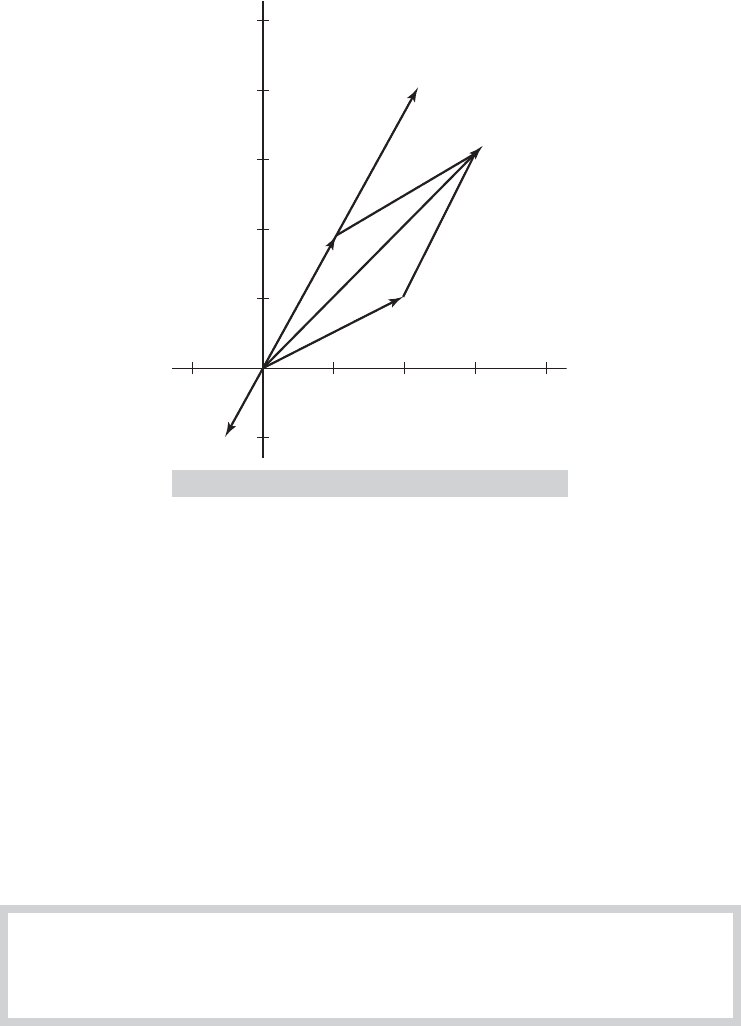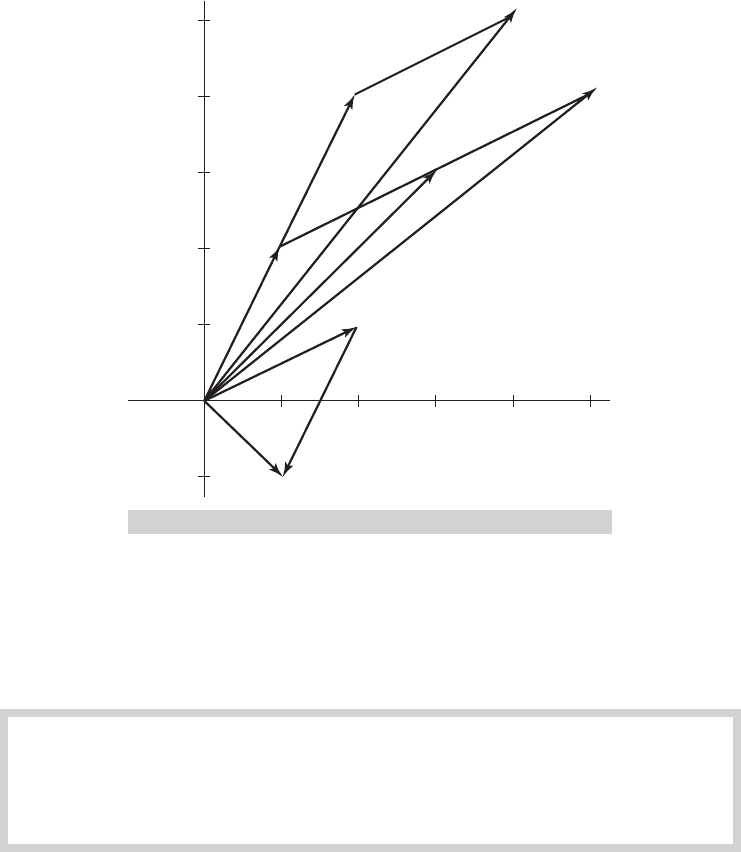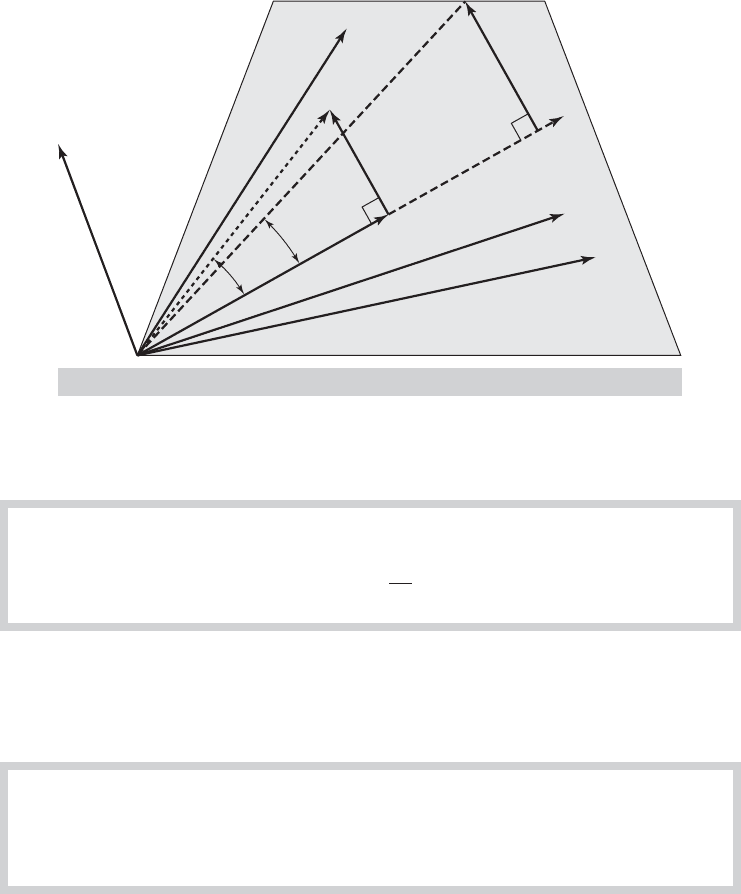Greene W.H. Econometric Analysis
Подождите немного. Документ загружается.


APPENDIX A
✦
Matrix Algebra
979
DEFINITION A.1
Idempotent Matrix
An idempotent matrix, M, is one that is equal to its square, that is, M
2
= MM = M.IfM
is a symmetric idempotent matrix (all of the idempotent matrices we shall encounter are
symmetric), then M
M = M.
Thus, M
0
is a symmetric idempotent matrix. Combining results, we obtain
n
i=1
(x
i
− ¯x )
2
= x
M
0
x. (A-37)
Consider constructing a matrix of sums of squares and cross products in deviations from the
column means. For two vectors x and y,
n
i=1
(x
i
− ¯x )(y
i
− ¯y) = (M
0
x)
(M
0
y), (A-38)
so
⎡
⎢
⎢
⎢
⎣
n
i=1
(x
i
− ¯x )
2
n
i=1
(x
i
− ¯x )(y
i
− ¯y )
n
i=1
(y
i
− ¯y)(x
i
− ¯x )
n
i=1
(y
i
− ¯y )
2
⎤
⎥
⎥
⎥
⎦
=
x
M
0
xx
M
0
y
y
M
0
xy
M
0
y
. (A-39)
If we put the two column vectors x and y in an n × 2 matrix Z = [x, y], then M
0
Z is the n × 2
matrix in which the two columns of data are in mean deviation form. Then
(M
0
Z)
(M
0
Z) = Z
M
0
M
0
Z = Z
M
0
Z.
A.3 GEOMETRY OF MATRICES
A.3.1 VECTOR SPACES
The K elements of a column vector
a =
⎡
⎢
⎣
a
1
a
2
···
a
K
⎤
⎥
⎦
can be viewed as the coordinates of a point in a K-dimensional space, as shown in Figure A.1
for two dimensions, or as the definition of the line segment connecting the origin and the point
defined by a.
Two basic arithmetic operations are defined for vectors, scalar multiplication and addition.A
scalar multiple of a vector, a, is another vector, say a
∗
, whose coordinates are the scalar multiple
of a’s coordinates. Thus, in Figure A.1,
a =
1
2
, a
∗
= 2a =
2
4
, a
∗∗
=−
1
2
a =
−
1
2
−1
.

980
PART VI
✦
Appendices
Second coordinate
5
4
3
2
1
1
b
c
a
a
*
a
**
1 1234
First coordinate
FIGURE A.1
Vector Space.
The set of all possible scalar multiples of a is the line through the origin, 0 and a. Any scalar
multiple of a is a segment of this line. The sum of two vectors a and b is a third vector whose
coordinates are the sums of the corresponding coordinates of a and b. For example,
c = a +b =
1
2
+
2
1
=
3
3
.
Geometrically, c is obtained by moving in the distance and direction defined by b from the tip of a
or, because addition is commutative, from the tip of b in the distance and direction of a. Note that
scalar multiplication and addition of vectors are special cases of (A-16) and (A-6) for matrices.
The two-dimensional plane is the set of all vectors with two real-valued coordinates. We label
this set R
2
(“R two,” not “R squared”). It has two important properties.
•
R
2
is closed under scalar multiplication; every scalar multiple of a vector in R
2
is also
in R
2
.
•
R
2
is closed under addition; the sum of any two vectors in the plane is always a vector
in R
2
.
DEFINITION A.2
Vector Space
A vector space is any set of vectors that is closed under scalar multiplication and
addition.
Another example is the set of all real numbers, that is, R
1
, that is, the set of vectors with one real
element. In general, that set of K-element vectors all of whose elements are real numbers is a
K-dimensional vector space, denoted R
K
. The preceding examples are drawn in R
2
.

APPENDIX A
✦
Matrix Algebra
981
Second coordinate
5
4
3
2
1
1
54321
a
a
*
d
e
c
b
f
First coordinate
FIGURE A.2
Linear Combinations of Vectors.
A.3.2 LINEAR COMBINATIONS OF VECTORS AND BASIS VECTORS
In Figure A.2, c =a + b and d =a
∗
+ b. But since a
∗
=2a, d =2a + b. Also, e =a + 2b and
f = b + (−a) = b − a. As this exercise suggests, any vector in R
2
could be obtained as a linear
combination of a and b.
DEFINITION A.3
Basis Vectors
A set of vectors in a vector space is a basis for that vector space if they are linearly inde-
pendent and any vector in the vector space can be written as a linear combination of that
set of vectors.
As is suggested by Figure A.2, any pair of two-element vectors, including a and b, that point
in different directions will form a basis for R
2
. Consider an arbitrary set of vectors in R
2
, a, b, and
c.Ifa and b are a basis, then we can find numbers α
1
and α
2
such that c = α
1
a +α
2
b. Let
a =
a
1
a
2
, b =
b
1
b
2
, c =
c
1
c
2
.
Then
c
1
= α
1
a
1
+ α
2
b
1
,
c
2
= α
1
a
2
+ α
2
b
2
.
(A-40)

982
PART VI
✦
Appendices
The solutions to this pair of equations are
α
1
=
b
2
c
1
− b
1
c
2
a
1
b
2
− b
1
a
2
,α
2
=
a
1
c
2
− a
2
c
1
a
1
b
2
− b
1
a
2
. (A-41)
This result gives a unique solution unless (a
1
b
2
− b
1
a
2
) = 0. If (a
1
b
2
− b
1
a
2
) = 0, then
a
1
/a
2
= b
1
/b
2
, which means that b is just a multiple of a. This returns us to our original condition,
that a and b must point in different directions. The implication is that if a and b are any pair of
vectors for which the denominator in (A-41) is not zero, then any other vector c can be formed
as a unique linear combination of a and b. The basis of a vector space is not unique, since any
set of vectors that satisfies the definition will do. But for any particular basis, only one linear
combination of them will produce another particular vector in the vector space.
A.3.3 LINEAR DEPENDENCE
As the preceding should suggest, K vectors are required to form a basis for R
K
. Although the
basis for a vector space is not unique, not every set of K vectors will suffice. In Figure A.2, a and
b form a basis for R
2
, but a and a
∗
do not. The difference between these two pairs is that a and b
are linearly independent, whereas a and a
∗
are linearly dependent.
DEFINITION A.4
Linear Dependence
A set of k ≥ 2 vectors is linearly dependent if at least one of the vectors in the set can be
written as a linear combination of the others.
Because a
∗
is a multiple of a, a and a
∗
are linearly dependent. For another example, if
a =
1
2
, b =
3
3
, and c =
10
14
,
then
2a +b −
1
2
c = 0,
so a, b, and c are linearly dependent. Any of the three possible pairs of them, however, are linearly
independent.
DEFINITION A.5
Linear Independence
A set of vectors is linearly independent if and only if the only solution to
α
1
a
1
+ α
2
a
2
+···+α
K
a
K
= 0
is
α
1
= α
2
=···=α
K
= 0.
The preceding implies the following equivalent definition of a basis.

APPENDIX A
✦
Matrix Algebra
983
DEFINITION A.6
Basis for a Vector Space
A basis for a vector space of K dimensions is any set of K linearly independent vectors in
that vector space.
Because any (K + 1)st vector can be written as a linear combination of the K basis vectors, it
follows that any set of more than K vectors in R
K
must be linearly dependent.
A.3.4 SUBSPACES
DEFINITION A.7
Spanning Vectors
The set of all linear combinations of a set of vectors is the vector space that is spanned by
those vectors.
For example, by definition, the space spanned by a basis for R
K
is R
K
. An implication of this
is that if a and b are a basis for R
2
and c is another vector in R
2
, the space spanned by [a, b, c]is,
again, R
2
. Of course, c is superfluous. Nonetheless, any vector in R
2
can be expressed as a linear
combination of a, b, and c. (The linear combination will not be unique. Suppose, for example,
that a and c are also a basis for R
2
.)
Consider the set of three coordinate vectors whose third element is zero. In particular,
a
= [
a
1
a
2
0
] and b
= [
b
1
b
2
0
].
Vectors a and b do not span the three-dimensional space R
3
. Every linear combination of a and
b has a third coordinate equal to zero; thus, for instance, c
= [1 2 3] could not be written as a
linear combination of a and b.If(a
1
b
2
−a
2
b
1
) is not equal to zero [see (A-41)]; however, then
any vector whose third element is zero can be expressed as a linear combination of a and b.So,
although a and b do not span R
3
, they do span something, the set of vectors in R
3
whose third
element is zero. This area is a plane (the “floor” of the box in a three-dimensional figure). This
plane in R
3
is a subspace, in this instance, a two-dimensional subspace. Note that it is not R
2
;it
is the set of vectors in R
3
whose third coordinate is 0. Any plane in R
3
that contains the origin,
(0, 0, 0), regardless of how it is oriented, forms a two-dimensional subspace. Any two independent
vectors that lie in that subspace will span it. But without a third vector that points in some other
direction, we cannot span any more of R
3
than this two-dimensional part of it. By the same logic,
any line in R
3
that passes through the origin is a one-dimensional subspace, in this case, the set
of all vectors in R
3
whose coordinates are multiples of those of the vector that define the line.
A subspace is a vector space in all the respects in which we have defined it. We emphasize
that it is not a vector space of lower dimension. For example, R
2
is not a subspace of R
3
.The
essential difference is the number of dimensions in the vectors. The vectors in R
3
that form a
two-dimensional subspace are still three-element vectors; they all just happen to lie in the same
plane.
The space spanned by a set of vectors in R
K
has at most K dimensions. If this space has fewer
than K dimensions, it is a subspace, or hyperplane. But the important point in the preceding
discussion is that every set of vectors spans some space; it may be the entire space in which the
vectors reside, or it may be some subspace of it.

984
PART VI
✦
Appendices
A.3.5 RANK OF A MATRIX
We view a matrix as a set of column vectors. The number of columns in the matrix equals the
number of vectors in the set, and the number of rows equals the number of coordinates in each
column vector.
DEFINITION A.8
Column Space
The column space of a matrix is the vector space that is spanned by its column
vectors.
If the matrix contains K rows, its column space might have K dimensions. But, as we have seen,
it might have fewer dimensions; the column vectors might be linearly dependent, or there might
be fewer than K of them. Consider the matrix
A =
⎡
⎣
156
268
718
⎤
⎦
.
It contains three vectors from R
3
, but the third is the sum of the first two, so the column space of
this matrix cannot have three dimensions. Nor does it have only one, because the three columns
are not all scalar multiples of one another. Hence, it has two, and the column space of this matrix
is a two-dimensional subspace of R
3
.
DEFINITION A.9
Column Rank
The column rank of a matrix is the dimension of the vector space that is spanned by its
column vectors.
It follows that the column rank of a matrix is equal to the largest number of linearly inde-
pendent column vectors it contains. The column rank of A is 2. For another specific example,
consider
B =
⎡
⎢
⎢
⎣
123
515
645
314
⎤
⎥
⎥
⎦
.
It can be shown (we shall see how later) that this matrix has a column rank equal to 3. Each
column of B is a vector in R
4
, so the column space of B is a three-dimensional subspace of R
4
.
Consider, instead, the set of vectors obtained by using the rows of B instead of the columns.
The new matrix would be
C =
⎡
⎣
1563
2141
3554
⎤
⎦
.
This matrix is composed of four column vectors from R
3
. (Note that C is B
.) The column space of
C is at most R
3
, since four vectors in R
3
must be linearly dependent. In fact, the column space of

APPENDIX A
✦
Matrix Algebra
985
C is R
3
. Although this is not the same as the column space of B, it does have the same dimension.
Thus, the column rank of C and the column rank of B are the same. But the columns of C are
the rows of B. Thus, the column rank of C equals the row rank of B. That the column and row
ranks of B are the same is not a coincidence. The general results (which are equivalent) are as
follows.
THEOREM A.1
Equality of Row and Column Rank
The column rank and row rank of a matrix are equal. By the definition of row rank and
its counterpart for column rank, we obtain the corollary,
the row space and column space of a matrix have the same dimension. (A-42)
Theorem A.1 holds regardless of the actual row and column rank. If the column rank of a
matrix happens to equal the number of columns it contains, then the matrix is said to have full
column rank. Full row rank is defined likewise. Because the row and column ranks of a matrix
are always equal, we can speak unambiguously of the rank of a matrix. For either the row rank
or the column rank (and, at this point, we shall drop the distinction),
rank(A) = rank(A
) ≤ min(number of rows, number of columns). (A-43)
In most contexts, we shall be interested in the columns of the matrices we manipulate. We shall
use the term full rank to describe a matrix whose rank is equal to the number of columns it
contains.
Of particular interest will be the distinction between full rank and short rank matrices. The
distinction turns on the solutions to Ax = 0. If a nonzero x for which Ax = 0 exists, then A does not
have full rank. Equivalently, if the nonzero x exists, then the columns of A are linearly dependent
and at least one of them can be expressed as a linear combination of the others. For example, a
nonzero set of solutions to
1310
2314
⎡
⎣
x
1
x
2
x
3
⎤
⎦
=
0
0
is any multiple of x
= (2, 1, −
1
2
).
In a product matrix C = AB, every column of C is a linear combination of the columns of
A, so each column of C is in the column space of A. It is possible that the set of columns in C
could span this space, but it is not possible for them to span a higher-dimensional space. At best,
they could be a full set of linearly independent vectors in A’s column space. We conclude that the
column rank of C could not be greater than that of A. Now, apply the same logic to the rows of
C, which are all linear combinations of the rows of B. For the same reason that the column rank
of C cannot exceed the column rank of A, the row rank of C cannot exceed the row rank of B.
Row and column ranks are always equal, so we can conclude that
rank(AB) ≤ min(rank(A), rank(B)). (A-44)
A useful corollary to (A-44) is
If A is M × n and B is a square matrix of rank n, then rank(AB) = rank(A). (A-45)

986
PART VI
✦
Appendices
Another application that plays a central role in the development of regression analysis is,
for any matrix A,
rank(A) = rank(A
A) = rank(AA
). (A-46)
A.3.6 DETERMINANT OF A MATRIX
The determinant of a square matrix—determinants are not defined for nonsquare matrices—is
a function of the elements of the matrix. There are various definitions, most of which are not
useful for our work. Determinants figure into our results in several ways, however, that we can
enumerate before we need formally to define the computations.
PROPOSITION
The determinant of a matrix is nonzero if and only if it has full rank.
Full rank and short rank matrices can be distinguished by whether or not their determinants
are nonzero. There are some settings in which the value of the determinant is also of interest, so
we now consider some algebraic results.
It is most convenient to begin with a diagonal matrix
D =
⎡
⎢
⎣
d
1
00··· 0
0 d
2
0 ··· 0
···
000··· d
K
⎤
⎥
⎦
.
The column vectors of D define a “box” in R
K
whose sides are all at right angles to one another.
3
Its “volume,” or determinant, is simply the product of the lengths of the sides, which we denote
|D|=d
1
d
2
...d
K
=
K
3
k=1
d
k
. (A-47)
A special case is the identity matrix, which has, regardless of K, |I
K
|=1. Multiplying D by a
scalar c is equivalent to multiplying the length of each side of the box by c, which would multiply
its volume by c
K
. Thus,
|cD|=c
K
|D|. (A-48)
Continuing with this admittedly special case, we suppose that only one column of D is multiplied
by c. In two dimensions, this would make the box wider but not higher, or vice versa. Hence,
the “volume” (area) would also be multiplied by c. Now, suppose that each side of the box were
multiplied by a different c, the first by c
1
, the second by c
2
, and so on. The volume would, by an
obvious extension, now be c
1
c
2
...c
K
|D|. The matrix with columns defined by [c
1
d
1
c
2
d
2
...]is
just DC, where C is a diagonal matrix with c
i
as its ith diagonal element. The computation just
described is, therefore,
|DC|=|D|·|C|. (A-49)
(The determinant of C is the product of the c
i
’s since C, like D, is a diagonal matrix.) In particular,
note what happens to the whole thing if one of the c
i
’s is zero.
3
Each column vector defines a segment on one of the axes.

APPENDIX A
✦
Matrix Algebra
987
For 2 × 2 matrices, the computation of the determinant is
*
*
*
*
ac
bd
*
*
*
*
= ad − bc. (A-50)
Notice that it is a function of all the elements of the matrix. This statement will be true, in
general. For more than two dimensions, the determinant can be obtained by using an expansion
by cofactors. Using any row, say, i, we obtain
|A|=
K
k=1
a
ik
(−1)
i+k
|A
ik
|, k = 1,...,K, (A-51)
where A
ik
is the matrix obtained from A by deleting row i and column k. The determinant of
A
ik
is called a minor of A.
4
When the correct sign, (−1)
i+k
, is added, it becomes a cofactor. This
operation can be done using any column as well. For example, a 4 × 4 determinant becomes a
sum of four 3 × 3s, whereas a 5 × 5 is a sum of five 4 × 4s, each of which is a sum of four 3 × 3s,
and so on. Obviously, it is a good idea to base (A-51) on a row or column with many zeros in
it, if possible. In practice, this rapidly becomes a heavy burden. It is unlikely, though, that you
will ever calculate any determinants over 3 × 3 without a computer. A 3 × 3, however, might be
computed on occasion; if so, the following shortcut due to P. Sarrus will prove useful:
*
*
*
*
*
*
a
11
a
12
a
13
a
21
a
22
a
23
a
31
a
32
a
33
*
*
*
*
*
*
= a
11
a
22
a
33
+ a
12
a
23
a
31
+ a
13
a
32
a
21
− a
31
a
22
a
13
− a
21
a
12
a
33
− a
11
a
23
a
32
.
Although (A-48) and (A-49) were given for diagonal matrices, they hold for general matrices
C and D. One special case of (A-48) to note is that of c =−1. Multiplying a matrix by −1 does
not necessarily change the sign of its determinant. It does so only if the order of the matrix is odd.
By using the expansion by cofactors formula, an additional result can be shown:
|A|=|A
| (A-52)
A.3.7 A LEAST SQUARES PROBLEM
Given a vector y and a matrix X, we are interested in expressing y as a linear combination of the
columns of X. There are two possibilities. If y lies in the column space of X, then we shall be able
to find a vector b such that
y = Xb. (A-53)
Figure A.3 illustrates such a case for three dimensions in which the two columns of X both have
a third coordinate equal to zero. Only y’s whose third coordinate is zero, such as y
0
in the figure,
can be expressed as Xb for some b. For the general case, assuming that y is, indeed, in the column
space of X, we can find the coefficients b by solving the set of equations in (A-53). The solution
is discussed in the next section.
Suppose, however, that y is not in the column space of X. In the context of this example,
suppose that y’s third component is not zero. Then there is no b such that (A-53) holds. We can,
however, write
y = Xb +e, (A-54)
where e is the difference between y and Xb. By this construction, we find an Xb that is in the
column space of X, and e is the difference, or “residual.” Figure A.3 shows two examples, y and y
∗
.
4
If i equals k, then the determinant is a principal minor.

988
PART VI
✦
Appendices
Third coordinate
First coordinate
Second coordinate
x
1
x
2
y
e
y
*
y
0
e
*
*
(Xb)
(Xb)
*
FIGURE A.3
Least Squares Projections.
For the present, we consider only y. We are interested in finding the b such that y is as close as
possible to Xb in the sense that e is as short as possible.
DEFINITION A.10
Length of a Vector
The length, or norm, of a vector e is given by the Pythagorean theorem:
e=
√
e
e. (A-55)
The problem is to find the b for which
e=y − Xb
is as small as possible. The solution is that b that makes e perpendicular, or orthogonal, to Xb.
DEFINITION A.11
Orthogonal Vectors
Two nonzero vectors a and b are orthogonal, written a ⊥ b, if and only if
a
b = b
a = 0.
Returning once again to our fitting problem, we find that the b we seek is that for which
e ⊥ Xb.
Expanding this set of equations gives the requirement
(Xb)
e = 0
= b
X
y −b
X
Xb
= b
[X
y − X
Xb],
